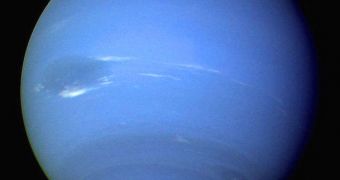The gas giant Neptune has finally completed its first orbit around the Sun since it was first discovered. The planet was observed on the night of September 23-24, 1846, and its first document orbit concluded yesterday, July 11, 2011, after 165 years.
Neptune is the eighth and farthest planet from the Sun, and its composition and physical/chemical characteristics are more closely related to those of Saturn, than to those of their largest siblings, Saturn and Jupiter.
Its atmosphere is primarily made up of hydrogen and helium gases. Traces of hydrocarbons and nitrogen may also exist in what passes as air on the planet. Unlike the larger gas giants thought, Neptune has larger concentrations of ices, including water, ammonia and methane.
Rightfully, it's this planet that should be called the Blue Planet, and not Earth, seeing how Neptune is, for all intents and purposes, blue. However, the name stuck with our planet by astronomical convention, Universe Today reports.
While yesterday marked the anniversary of Neptune’s first full barycentric orbit, today, July 12, marks the planet's heliocentric completion. Calculations indicate that the object completes a full rotation around the Sun once every 164.79 years.
Interestingly, the first to observe and draw Neptune – though he did not know what he was seeing – was Galileo. He conducted observations of the gas giants on the nights of December 28, 1612, and January 27, 1613, but though he was seeing a fixed star.
“It has been known for several decades that this unknown star was actually the planet Neptune,” explains research scientist David Jamieson, who holds an appointment as a physicist at the University of Melbourne, in Australia.
“Computer simulations show the precision of his observations revealing that Neptune would have looked just like a faint star almost exactly where Galileo observed it,” the investigator goes on to say.
Eventually, credit for the discovery of the planet went to French mathematician Urbain Jean Joseph Le Verrier (1811 – 1877), who succeeded in both predicting the object's location based on calculation, and in convincing others to search for it.
British mathematician and astronomer John Couch Adams (1819 – 1892) is also credited with coming up with the necessary calculations to establish Neptune's position, independent from Le Verrier.
Initially, both were awarded recognition for discovering the planet, but historical reconsideration has since proven that Le Verrier was more entitled to the praise than Adams. What is remarkable about the work both researchers put forth is that they mostly used mathematics to propose Neptune's existence.

 14 DAY TRIAL //
14 DAY TRIAL //